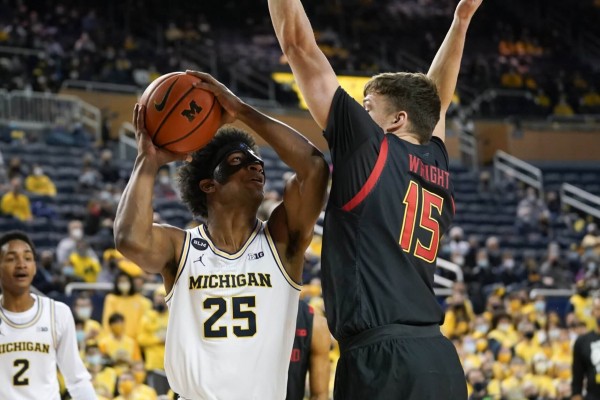WHAT’S WRONG WITH MICHIGAN? -- It’s a lot of little things add up
National Notebook : WHAT’S WRONG WITH MICHIGAN? -- It’s a lot of little things add up

It’s been a hot topic for the wrong reason, and not just in Ann Arbor, Mich. And not just in Big Ten Conference circles.
What’s wrong with University of Michigan basketball?
The Wolverines brought in the nation’s best recruiting class for the 2021-22 season, started out ranked fourth in the country and won their first two games. ow they’re 8-7 following a January 18 home win over Maryland, begging the question posed above.
There are no easy answers, just a mixture of a lot of little things that have accumulated to the point where now, combined, they have plagued Michigan from the start.
- Critical losses from last year’s team.
- A young, inexperienced roster this season.
- Teams packing it in against U-M 7-foot-1 center Hunter Dickinson, and Michigan responding with sketchy perimeter play and three-point shooting.
- Even sketchier free throw shooting.
- Trouble defending opponents’ three-point shooting.
- And, like many teams, a seemingly unwinnable battle with COVID-19 that has already caused games against top-10 teams Michigan State and Purdue to be postponed – albeit, given the timing, it might not have been such a bad thing – and was a contributing factor when four players and a staff member contracted the virus right before a loss to Rutgers. Dickinson and Brandon Johns Jr. traveled to Illinois, but third-year coach Juwan Howard decided not to risk their health and sat them both in an eventual 68-53 loss.
Singularly, the issues can certainly be worked on and overcome.
Collectively, it’s a lot on Howard’s plate at once.
And while last year’s national coach of the year for guiding the Wolverines to a Big Ten regular season championship and a No. 1 seed in the NCAA Tournament might not be listening, he is hearing what fans, local media and national pundits are saying.
“There are a lot of different outside voices when you’re losing, and outside voices have all the answers,” Howard said during one of his recent weekly radio shows. “When you’re at home you can say, ‘I could make that shot’ or ‘I can box a guy out’ or ‘I could play better defense than that.’ Once you get out on that floor, it’s a new ball game.”
Still, the Wolverines have held up remarkably well in the face of not reaching expectations – yet – if not downright adversity.
“It hasn’t been the ideal season we wanted so far,” said Jace Howard, Juwan’s 6-7 sophomore son, “but we’re excited for the opportunity that we have ahead.”
Let’s break it down point by point.
IT’S NOT LAST YEAR’S TEAM
The 2021 Wolverines had a special kind of dynamic in winning their first regular-season conference title in seven years and coming up a game shy of the NCAA Final Four after a 51-49 loss to 11th-seeded UCLA in a regional final.
But that team lost four of its top six scorers to professional basketball. Franz Wagner and Isaiah Livers are now playing for the Orlando Magic and Detroit Pistons in the NBA, respectively – with Wagner an early-season Rookie of the Year candidate – and Chaundee Brown and Mike Smith are playing in the NBA G-League.
That’s 43 points and 11 assists per game to make up for.
YOUTH PERVADES THE ROSTER
In this day and age of one-and-done, fans and even the media expect freshmen to step in right away and dominate before declaring for the Draft. Especially when you pull in a No. 1 class. But those are the anomalies.
In reality. Michigan has an extraordinarily youthful roster. There are seven freshmen, four sophomores, no juniors, four seniors – only two of whom are in the rotation – and two graduate students. With that amount of inexperience, there are bound to be mistakes.
But many of them are mental mistakes, or mistakes of omission. For instance, in a December 30 game against UCF, the Wolverines led by 12 in the second half and lost by 14, thanks largely to an 18-2 run by the Knights.
“We lost our composure,” said Devante Jones, a graduate transfer from Coastal Carolina. “We let them hit shots and the crowd noise got to us and we started making a lot of mental mistakes that we don’t make. Once those mistakes compound with each other, and they start hitting shots, it will be hard to beat those guys. And we had some crucial turnovers down the stretch, including myself. … We have to be a two-half team. We can’t be a one-half team. We’ll never win that way.”
TEAMS ARE DARING MICHIGAN TO SHOOT THE THREE
Opponents are daring U-M to shoot from the perimeter as they pack the middle against Dickinson. The sophomore big man is averaging 16.1 points per game, two more than last year, but he’s scratching, clawing and biting his way to get there as Michigan struggles to develop an outside game.
Last season, the Wolverines hit 48.2 percent of their field goal attempts, including 38.1 percent from three-point range.
So far this year, it’s 46.3 percent from the field overall and 33.1 percent from beyond the arc. Only Jones, with a 46.2 percent make ratio from three-point land, has shown a consistent touch. Of the nine players who have appeared in at least 11 games and played at least 12 minutes per game, five are at 33.3 percent or lower – including three under 30 percent.
Nonetheless, the Wolverines’ coaching staff has encouraged the players to keep shooting.
“If (the team) is thinking anything other than ‘This ball is going in,’ then we can’t defeat that. It’s just a gorilla on somebody’s back,” said associate head coach Phil Martelli, the longtime St. Joseph’s head coach. “So you want them to take that next shot, take that next shot, take that next shot. If there’s a tweak to be made, spring and summer is when we make that tweak.”
Said Howard: “You’ve got to be careful in what you demand of your group... Keep encouraging is the most important thing.”
FREE THROW SHOOTING IS DOWN
Last year, U-M was 27th in the country in free throw shooting, making them at a 76.9 percent clip. Fourteen games into this season, Michigan is 285th in the nation at 67.4 percent. Enough said.
TEAM DEFENSE ISN’T ROTATING AT KEY MOMENTS
From an overall perspective, Michigan’s defense has been good. The Wolverines are holding opponents to 41.2 percent shooting from the field and only 29.1 percent from three-point range.
As any coach will tell you, however, numbers might not lie but they can be deceiving. It’s not so much how the defense is reacting and rotating, but when.
In the loss to Rutgers, the Scarlet Knights shot almost 48 percent against the Wolverines from three-point range. And UCF was absolutely scorching from trey, hitting 60 percent.
Take away those two losses, put Michigan at 9-5 instead of 7-7, and we’re likely not having the ‘What’s wrong with Michigan?’ conversation.
COVID IS $&)@$^( UP A LOT OF THINGS
Jace Howard started the season being listed as a 6-7, 225-pound guard on Michigan’s roster. Later, his position designation was changed from guard to forward. In the loss to Illinois on January 14, Jace Howard played the five and guarded the Illini’s 7-foot, 285-pound superstar center, Kofi Cockburn.
Cockburn finished with another double-double, 21 points and 10 rebounds, but the bigger picture is how COVID wreaks havoc for days – if not weeks – on teams.
“We’ve had very unorthodox practices as of late,” Juwan Howard said. “We haven’t had 10 players to practice in the last week or so. For those who are available, we do what can we do to get them ready. Some programs have dealt with it. We’re certainly not the first but when it’s you you get to see how challenging it is.”
Not that his son minded. Jace Howard said his defensive assignment just epitomizes the strength of the brotherhood of the team and a ‘whatever it takes’ attitude.
“They knew that I was willing to do that especially in the situation we were in,” Jace said of his father and the coaching staff. “It was what we needed. I wanted it. How many times in your career can you guard a preseason All-American and potential National Player of the Year?”
Matchup issues aside, Juwan Howard sees the hard work and the talent far more than the ‘outside voices’ he referenced on his radio show.
“I see so many great things,” the coach said. “I’m all-in with this group.”



